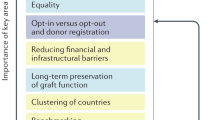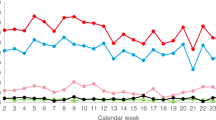Abstract
Between 1988 and 2007, international searches for matched unrelated donors (MUDs) were performed for 1586 Austrian patients. Between 2004 and 2007, a MUD was identified for 76.7% of the patients. Between 1996 and 2003, a donor was identified for 71.3% of the patients, and between 1988 and 1995, only for 53.4% of the patients. Search times of successful searches decreased from 7.7 months in the first period to 1.7 months in the period from 2004 to 2007. However, transplants were not performed in all cases in which a donor was found: only in 61.6% of the patients between 2004 and 2007, in 53.4% between 1996 and 2003 and in 29.6% between 1988 and 1995. Multivariate analysis determined that having a common HLA type was the most important variable impacting on finding a MUD for a patient. Factors that most strongly influence a patient's access to transplant were the patient's European origin and a short time between diagnosis and start of donor search. The strongest factor for both finding a donor and being transplanted was a search being performed during more recent years: patients’ chances increased from year to year.
This is a preview of subscription content, access via your institution
Access options
Subscribe to this journal
Receive 12 print issues and online access
$259.00 per year
only $21.58 per issue
Buy this article
- Purchase on Springer Link
- Instant access to full article PDF
Prices may be subject to local taxes which are calculated during checkout


Similar content being viewed by others
References
Rowe JM, Goldstone AH . How I treat lymphocytic leukemia in adults. Blood 2007; 110: 2268–2275.
Goldman JM . How I treat chronic myeloid leukemia in the imatinib era. Blood 2007; 110: 2828–2837.
Dahlke J, Kröger N, Zabelina T, Ayuk F, Fehse N, Wolschke C et al. Comparable results in patients with acute lymphoblastic leukemia after related and unrelated stem cell transplantation. Bone Marrow Transplant 2006; 37: 155–163.
Kiehl MG, Kraut L, Schwerdtfeger R, Hertenstein B, Remberger M, Kroeger N et al. Outcome of allogeneic hematopoietic stem-cell transplantation in adult patients with acute lymphoblastic leukemia: No difference in related compared with unrelated transplant in first complete remission. J Clin Oncol 2004; 22: 2816–2825.
Weisdorf DJ, Anasetti C, Antin JH, Kollman C, Snyder D, Petersdorf E et al. Allogeneic bone marrow transplantation for chronic myelogenous leukaemia: comparative analysis of unrelated versus matched sibling donor transplantation. Blood 2002; 99: 1971–1977.
Moore J, Nivison-Smith I, Goh K, Ma D, Bradstock K, Szer J et al. Equivalent survival for sibling and unrelated donor allogeneic stem cell transplantation for acute myelogenous leukaemia. Biol Blood Marrow Transplant 2007; 13: 601–607.
Yakoub-Agha I, Mesnil F, Kuentz M, Boiron JM, Ifrah N, Milpied N et al. Allogeneic marrow stem-cell transplantation from human leukocyte antigen-identical siblings versus human leukocyte antigen-allelic-matched unrelated donors (10/10) in patients with standard-risk hematologic malignancy: a prospective study from the french society of bone marrow transplantation and cell therapy. J Clin Oncol 2006; 36: 5695–5702.
Van Rood JJ, Oudshoorn M . Eleven million donors in Bone Marrow Donors Worldwide! Time for reassessment? Bone Marrow Transplant 2008; 41: 1–9.
Statistik Austria (ed.). Volkszählung 2001, Textband. Die demographische, soziale und wirtschaftliche Struktur der österreichischen Bevölkerung. Statistik Austria: Vienna, 2007.
Hurley CK, Maiers M, Marsh SGE, Oudshoorn M . Overview of registries, HLA typing and diversity, and search algorithms. Tissue Antigens 2007; 69: 3–5.
Oudshoorn M, Horn PA, Tilanus M, Yu N . Typing of potential and selected donors for transplant: methodology and resolution. Tissue Antigens 2007; 69: 10–12.
Chalandon Y, Tiercy J-M, Schanz U, Gungor T, Seger R, Halter J et al. Impact of high-resolution matching in allogeneic unrelated donor stem cell transplantation in Switzerland. Bone Marrow Transplant 2006; 37: 909–916.
Kawase T, Morishima Y, Matsuo K, Kashiwase K, Inoko H, Saji H et al. High-risk HLA allele mismatch combinations responsible for severe acute graft-versus-host disease and implication for its molecular mechanism. Blood 2007; 110: 2235–2241.
Petersdorf EW, Gooley T, Malkki M, Horowitz M . Clinical significance of donor-recipient HLA matching on survival after myeloablative hematopoietic cell transplantation from unrelated donors. Tissue Antigens 2007; 69: 25–30.
Lee SJ, Klein J, Haagenson M, Baxter-Lowe LA, Confer DL, Eapen M et al. High-resolution donor-recipient HLA matching contributes to the success of unrelated donor marrow transplantation. Blood 2007; 110: 4576–4583.
Shaw BE, Gooley TA, Malkki M, Madrigal AJ, Begovich AB, Horowitz MM et al. The importance of HLA-DPB1 in unrelated donor hematopoietic cell transplantation. Blood 2007; 110: 4560–4566.
Tiercy J-M, Passweg J, van Biezen A, Zander A, Kröger N, Gratwohl A et al. Isolated HLA-C mismatches in unrelated donor transplantation for CML. Bone Marrow Transplant 2004; 34: 249–255.
Boucher K, Mori M, Milford E, Beatty PG . Estimation of HL-A,-B,-DR frequencies in five racial groups represented in the NMDP donor file. In: Gjertson, D. P., Terasaki, P. E. (eds). HLA 1998. ASHI: Lenexa, KS, USA, 1998 pp 57–78.
Tiercy J-M, Nicoloso G, Passweg J, Schanz U, Seger R, Chalandon Y et al. The probability of identifying a 10/10 HLA allele-matched unrelated donor is highly predictable. Bone Marrow Transplant 2007; 40: 515–522.
Heemskerk MBA, van Walraven SM, Cornelissen JJ, Barge RMY, Bredius RGM, Egeler RM et al. How to improve the search for an unrelated haematopoietic stem cell donor. Faster is better than more! Bone Marow Transplant 2005; 35: 645–652.
Tiercy J-M, Bujan-Lose M, Chapuis B, Gratwohl A, Gmür J, Seger R et al. Bone marrow transplantation with unrelated donors: what is the probability of identifying an HLA-A/B/Cw/DRB1/B3/B5/DQB1-matched donor? Bone Marrow Transplant 2000; 26: 437–441.
Kaplan EL, Meier P . Non parametric estimation from incomplete observations. J Am Stat Assoc 1958; 53: 457–481.
Cox DR . Regression models and life tables. J R Stat Soc 1972; 34: 187.
R Development Core Team. R: A language and environment for statistical computing. R Foundation for Statistical Computing: Vienna, Austria, 2008, ISBN 3-300051-07-0, http://www.R-project.org.
Therneau T, Lumley T (2008). Survival: Survival analysis, including penalised likelihood. R Package version 2. 34-1.
Tiercy J-M, Villard J, Roosnek E . Selection of unrelated bone marrow donors by serology, molecular typing and cellular assays. Transplant Immunol 2002; 10: 215–221.
Goldman JM . Special report: Bone marrow transplants using volunteer donors–recommendations and requirements for a standardized practice throughout the world–1994 update. Blood 1994; 84: 2833–2839.
Hurley C, Raffoux C . Special report: World Marrow Donor Association: international standards for unrelated haematopoietic stem cell registries. Bone Marrow Transplant 2004; 34: 103–110.
Baouz A, Raffoux C . EMDIS: European Marrow Donor Information System. Comput Methods Programs Biomed 1994; 45: 45–46.
Müller CH . Computer applications in the search for unrelated stem cell donors. Transplant Immunol 2002; 10: 227–240.
Acknowledgements
Dagmar Jenner is thanked for expert editorial assistance. This work has been supported by the Jubiläumsfonds der Oesterreichischen National bank, Project Nr. 6658 and by the Austrian Ministry of Health.
Author information
Authors and Affiliations
Corresponding author
Ethics declarations
Competing interests
The authors declare no conflict of interest.
Rights and permissions
About this article
Cite this article
Rosenmayr, A., Pointner-Prager, M., Mitterschiffthaler, A. et al. What are a patient's current chances of finding a matched unrelated donor? Twenty years’ central search experience in a small country. Bone Marrow Transplant 47, 172–180 (2012). https://doi.org/10.1038/bmt.2011.67
Received:
Revised:
Accepted:
Published:
Issue Date:
DOI: https://doi.org/10.1038/bmt.2011.67
Keywords
This article is cited by
-
Two decades of experience in a combined adult/pediatric allogeneic hematopoietic stem cell transplantation center in Algiers, Algeria
Annals of Hematology (2020)
-
“Worldwide Network for Blood & Marrow Transplantation (WBMT) special article, challenges facing emerging alternate donor registries”
Bone Marrow Transplantation (2019)
-
First report of pediatric hematopoietic stem cell transplantation activities in the eastern mediterranean region from 1984 to 2011: on behalf of the pediatric cancer working committee of the eastern mediterranean blood and marrow transplantation group
Bone Marrow Transplantation (2017)



